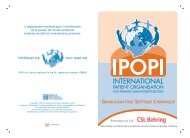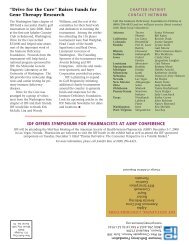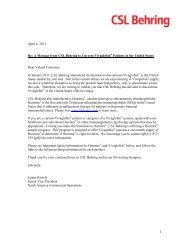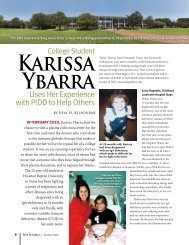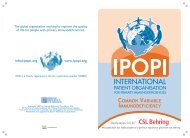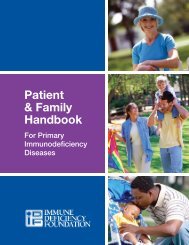Stem Cell Therapy and Gene Therapy
Stem Cell Therapy and Gene Therapy
Stem Cell Therapy and Gene Therapy
Create successful ePaper yourself
Turn your PDF publications into a flip-book with our unique Google optimized e-Paper software.
<strong>Stem</strong> <strong>Cell</strong> <strong>Therapy</strong> <strong>and</strong> <strong>Gene</strong> <strong>Therapy</strong><br />
(Selecting a Donor continued)<br />
matched unrelated donor is the best first choice option.<br />
The best choice depends on many factors including:<br />
• The type of SCID or primary immunodeficiency<br />
disease<br />
• How much immune function remains<br />
• The degree of matching of potential donors<br />
• The types of HSCT available (cord blood vs.<br />
bone marrow)<br />
• The age of the patient<br />
• How sick they are <strong>and</strong> what types of<br />
complications they have had<br />
Procedures<br />
HSC are “harvested” from the donor by removing bone<br />
marrow from the pelvic bones. Bone marrow is removed<br />
by drawing the marrow up through a needle that is<br />
about 1/8 of an inch in diameter. Only two teaspoons<br />
are taken from each puncture site because, if more is<br />
taken, the sample is diluted with the blood that flows<br />
through the bone marrow space. Bringing blood with the<br />
bone marrow increases the risk of the sample carrying<br />
the mature T-cells that have the potential to cause<br />
GVHD.<br />
Usually, two teaspoons are taken for each two pounds of<br />
the recipient’s body weight. The average donor might<br />
have only a few punctures performed to get enough<br />
stem cells for a baby, but more than 100 punctures may<br />
be required to get enough stem cells for a teen or full<br />
sized adult. The procedure may be performed under<br />
general anesthesia or under spinal anesthesia. The<br />
discomfort after the procedure varies from donor to<br />
donor.<br />
Almost all donors will require some type of pain control<br />
medication for two to three days after the procedure, but<br />
most donors are not required to stay in the hospital<br />
overnight <strong>and</strong> are able to return to full activity shortly<br />
afterwards. The donor’s immune system is not<br />
compromised because HSC <strong>and</strong> marrow quickly<br />
regenerate.<br />
Once it has been harvested, the bone marrow is passed<br />
through a fine sieve to remove any small particles of<br />
bone <strong>and</strong> processed further, if necessary, to remove<br />
incompatible red blood cells, or to remove T-cells. It is<br />
then placed into a sterile plastic bag <strong>and</strong> infused into<br />
the host intravenously just like a blood transfusion.<br />
As an alternative to bone marrow harvesting, HSC can<br />
be obtained from peripheral blood <strong>and</strong> then purified via<br />
a process known as apheresis. The donor’s blood is<br />
collected from an arm vein, using a needle that is<br />
connected with a machine that removes the white blood<br />
cells. After white blood cells are removed from the<br />
blood, the remaining red blood cells are then returned<br />
to the donor via a vein in the opposite arm. The HSC are<br />
then purified from the other white blood cells. Typically,<br />
in order to enrich the amount of HSC in peripheral<br />
blood, the donor receives subcutaneous injections of<br />
granulocyte-colony stimulating factor (G-CSF) or of<br />
plerixafor in the days that precede the blood collection.<br />
Both G-CSF <strong>and</strong> plerixafor mobilize the HSC from the<br />
bone marrow, transferring them into peripheral blood, so<br />
that a large number of HSC are present in the<br />
peripheral blood before the apheresis procedure.<br />
IDF Patient & Family H<strong>and</strong>book | 156








